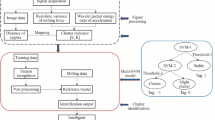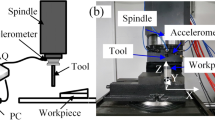Abstract
Chatter is a kind of self-excited vibration that often occurs in the milling process of thin-walled parts, which has become the main factor restricting production efficiency and quality. Due to the occurrence of chatter, the signal becomes more complex and unstable. In order to realize milling chatter detection of thin-walled parts, the method of multi-sensor signal fusion is used. A chatter detection method based on variational mode decomposition (VMD) and nonlinear dimensionless index is proposed by analyzing the characteristics of signals in time–frequency domain. Firstly, a series of intrinsic mode function (IMF) components are obtained by decomposing force and acceleration signals with VMD. When chatter occurs, the energy is transferred to the chatter frequency band. Each IMF signal’s nonlinear energy entropy (EE) is extracted to construct the feature vector. A support vector machine chatter identification model based on multi-sensor signal fusion is established. To solve the problem of model incremental updating, supervised learning and unsupervised learning are combined to provide a method for chatter detection.


















Similar content being viewed by others
Data availability
The datasets used or analyzed during the current study are available from the corresponding author on reasonable request.
Code availability
Not applicable.
Abbreviations
- EE:
-
Energy entropy
- VMD:
-
Variational modal decomposition
- IMF:
-
Intrinsic mode function
- FFT:
-
Fast Fourier transform
- SOM:
-
Self-organizing feature map
- SVM:
-
Support vector machine
- WPT:
-
Wavelet packet decomposition
- EMD :
-
Empirical mode decomposition
- RBF:
-
Radial basis kernel function
- SLD:
-
Stability lobe diagram
- IL-KM-SVM:
-
Incremental K-means and SVM
- IL-KM:
-
Incremental K-means
- IL-SVM :
-
Incremental SVM
- BO:
-
Bayesian optimization
- EK :
-
Envelope kurtosis
- f(t):
-
The time series of the signal
- u k(t):
-
The kth IMF of signal time series decomposition
- A k(t):
-
The instantaneous amplitude of the kth IMF
- \({\phi }_{k}(t)\) :
-
The phase of the kth IMF
- \({\omega }_{k}(t)\) :
-
Instantaneous frequency
- \(\delta (t)\) :
-
Unit pulse function
- \(\otimes\) :
-
Convolution operation
- \({\partial }_{t}\) :
-
Gradient operation
- \(\lambda \left(t\right)\) :
-
Lagrange multiplication operator
- L :
-
Lagrange multiplier
- \(\alpha\) :
-
VMD penalty factor
- K :
-
Decomposition level
- \({\omega }_{k}^{n+1}\) :
-
Center frequency of each IMF
- e :
-
Convergence error
- n :
-
Number of iterations
- \(\zeta\) :
-
Relative error
- E0:
-
Total energy
- E i :
-
Energy of each IMF component
- P i :
-
Energy share of each IMF
- H E :
-
Energy entropy of the signal decomposed by VMD
- \({x}_{o}\left(t\right)\) :
-
Absolute value obtained by Hilbert transform
- \(x\left(t\right)\) :
-
Original signal
- F z :
-
Tooth passing frequency
- Z :
-
Number of tool teeth
- n s :
-
Spindle speed
- a p :
-
Axial cutting depth
- a e :
-
Radial cutting width
- V f :
-
Feed rate
- c :
-
SVM Penalty factor
- g :
-
Core parameter
- K t :
-
Tangential cutting force coefficient
- K r :
-
Radial cutting force coefficient
References
Quintana G, Ciurana J (2011) Chatter in machining processes: a review. Int J Mach Tools Manuf 51(5):363–376
Siddhpura M, Paurobally R (2012) A review of chatter vibration research in turning. Int J Mach Tools Manuf 60:27–47
Kim SJ, Lee HU, Cho DW (2007) Prediction of chatter in NC machining based on a dynamic cutting force model for ball end milling. Int J Mach Tools Manuf 47(12):1827–1838
Lamraoui M, Thomas M, Badaoui ME (2014) Cyclostationarity approach for monitoring chatter and tool wear in high-speed milling. Mech Syst Signal Process 44(1–2):177–198
Tansel IN, Demetgul M, Bickraj K, Kaya B, Ozcelik B (2013) Basic computational tools and mechanical hardware for torque-based diagnostic of machining operations. J Intell Manuf 24(1):147–161
Hino J, Yoshimura T (2000) Prediction of chatter in high-speed milling by means of fuzzy neural networks. Int J Syst Sci 31(10):1323–1330
Huang PL, Li JF, Sun J, Ge MJ (2012) Milling force vibration analysis in high-speed-milling titanium alloy using variable pitch angle mill. Int J Adv Manuf Technol 58(1–4):153–160
Feng JL, Sun ZL, Jiang ZH, Yang L (2016) Identification of chatter in milling of Ti-6Al-4V titanium alloy thin-walled workpieces based on cutting force signals and surface topography. Int J Adv Manuf Technol 82(9–12):1909–1920
Li K, He SP, Li B, Liu HQ, Mao XY, Shi CM (2020) A novel online chatter detection method in milling process based on multiscale entropy and gradient tree boosting. Mech Syst Signal Process 135:106385
Kang J, Feng CJ, Hu HY (2007) Shao Q (2007) Research on chatter prediction and monitor based on DHMM pattern recognition theory. IEEE Int Conf Autom Logist 2007(1):1368–1372
Fu Y, Zhang Y, Zhou HM, Li DQ, Liu HQ, Qiao HY, Wang XQ (2016) Timely online chatter detection in end milling process. Mech Syst Signal Process 75:668–688
Sun YX, Xiong ZH (2016) An optimal weighted wavelet packet entropy method with application to real-time chatter detection. IEEE/ASME Trans Mechatron 21(4):2004–2014
Cao HR, Lei YG, He ZJ (2013) Chatter identification in end milling process using wavelet packets and Hilbert-Huang transform. Int J Mach Tools Manuf 69:11–19
Caliskan H, Kilic ZM, Altintas Y (2018) On-line energy-based milling chatter detection. J Manuf Sci Eng 140(11):111012
Yao ZH, Mei DQ, Chen ZC (2010) On-line chatter detection and identification based on wavelet and support vector machine. J Mater Process Technol 210(5):713–719
Yesilli MC, Khasawneh FA, Otto A (2020) On transfer learning for chatter detection in turning using wavelet packet transform and empirical mode decomposition. CIRP J Manuf Sci Technol 28:118–135
Ji YJ, Wang XB, Liu ZB, Wang HJ, Jiao L, Wang DQ, Leng SY (2018) Early milling chatter identification by improved empirical mode decomposition and multi-indicator synthetic evaluation. J Sound Vib 433:138–159
Wang YX, Market R, Xiang JW, Zheng WG (2015) Research on variational mode decomposition and its in detecting rub-impact fault of the rotor system. Mech Syst Signal Process 60–61:243–251
Yang K, Wang GF, Dong Y, Zhang QB, Sang LL (2019) Early chatter identification based on an optimized variational mode decomposition. Mech Syst Signal Process 115:238–254
Liu XL, Wang ZX, Li MY, Yue CX, Liang SY, Wang LH (2021) Feature extraction of milling chatter based on optimized variational mode decomposition and multi-scale permutation entropy. Int J Adv Manuf Technol 144(9–10):2849–2862
Lamraoui M, Barakat M, Thomas M, El Badaoui M (2015) Chatter detection in milling machines by neural network classification and feature selection. J Vib Control 21(7):1251–1266
Liu CF, Zhu LD, Ni CB (2018) Chatter detection in milling process based on VMD and energy entropy. Mech Syst Signal Process 105(1):169–182
Zhang Z, Li HG, Meng G, Tu XT, Cheng CM (2016) Chatter detection in milling process based on the energy entropy of VMD and WPD. Int J Mach Tools Manuf 108:106–112
Kumar S, Singh B (2019) Chatter prediction using merged wavelet denoising and ANFIS. Methodologies Appl 23(12):4439–4458
Chen HG, Shen JY, Chen WH, Yi YY, Qian JC (2019) Grinding chatter detection and identification based on BEMD and LSSVM. Chinese J Mech Eng 32(1):90–102
Wan SK, Li XH, Yin YJ, Hong J (2021) Milling chatter detection by multi-feature fusion and Adaboost-SVM. Mech Syst Signal Process 156:107671
Wang LM, Pan JL, Shao YM, Zeng Q, Ding XX (2021) Two new kurtosis-based similarity evaluation indicators for grinding chatter diagnosis under non-stationary working conditions. Measurement 176:109215
Wang RQ, Song QH, Liu ZQ, Ma HF, Gupta MK, Liu ZJ (2021) A novel unsupervised machine learning-based method for chatter detection in the milling of thin-walled parts. Sensors 21(17):5779–5779
Dun YC, Zhu LD, Yan BL, Wang SH (2021) A chatter detection method in milling of thin-walled TC4 alloy workpiece based on auto-encoding and hybrid clustering. Mech Syst Signal Process 158:107755
Li DD, Zhang WM, Li YS, Xue F, Fleischer J (2021) Chatter identification of thin-walled parts for intelligent manufacturing based on multi-signal processing. Adv Manuf 9(1):22–33
Dragomiretskiy K, Zosso D (2014) Variational mode decomposition. IEEE Trans Signal Process 62(3):531–544
Shahriari B, Swersky K, Wang ZY, Adams RP, de Freitas N (2015) Taking the human out of the loop: a review of Bayesian optimization. Proc IEEE 104(1):148–175
Ding Y, Zhu LM, Zhang XJ, Ding H (2010) A full-discretization method for prediction of milling stability. Int J Mach Tools Manuf 50(5):502–509
Ding Y, Zhu LM, Zhang XJ, Ding H (2010) Second-order full-discretization method for milling stability prediction. Int J Mach Tools Manuf 50(10):926–932
Zheng XX, Zhou GW, Ren HH, Fu Y (2017) A rolling bearing fault diagnosis method based on variational mode decomposition and permutation entropy. J Vib Shock 36(22):22–28
Funding
This research was supported by the National Natural Science Foundation of China (Grant Number 52175393).
Author information
Authors and Affiliations
Contributions
Mingwei Zhao has organized the project, analyzed and arranged data, and wrote the manuscript; Caixu Yue contributed the experiments and collected and analyzed data; Xianli Liu helped perform the analysis with constructive discussions.
Corresponding author
Ethics declarations
Ethics approval
The content studied in this article belongs to the field of metal processing and does not involve humans and animals. This article strictly follows the accepted principles of ethical and professional conduct.
Consent to participate
My co-authors and I would like to opt in to In Review.
Consent for publication
I agree with the Copyright Transfer Statement.
Conflict of interest
The authors declare no competing interests.
Additional information
Publisher's note
Springer Nature remains neutral with regard to jurisdictional claims in published maps and institutional affiliations.
Rights and permissions
Springer Nature or its licensor (e.g. a society or other partner) holds exclusive rights to this article under a publishing agreement with the author(s) or other rightsholder(s); author self-archiving of the accepted manuscript version of this article is solely governed by the terms of such publishing agreement and applicable law.
About this article
Cite this article
Zhao, M., Yue, C. & Liu, X. Research on milling chatter identification of thin-walled parts based on incremental learning and multi-signal fusion. Int J Adv Manuf Technol 125, 3925–3941 (2023). https://doi.org/10.1007/s00170-023-10944-x
Received:
Accepted:
Published:
Issue Date:
DOI: https://doi.org/10.1007/s00170-023-10944-x




